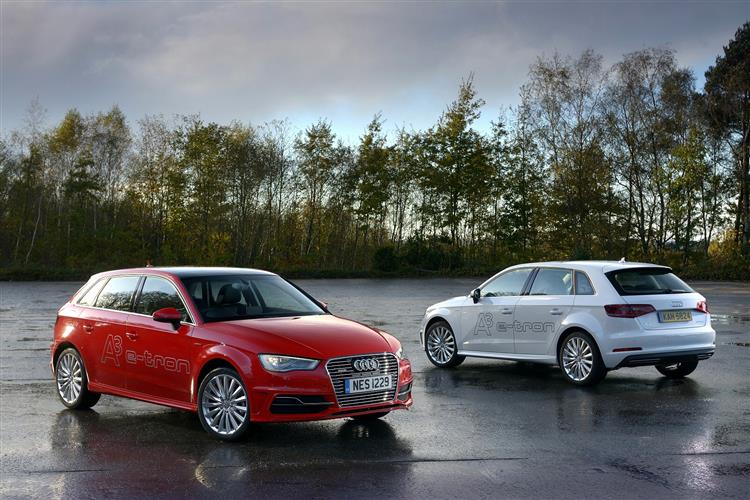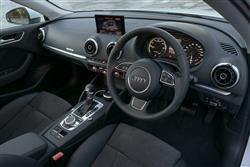This is a sample, showing 30 seconds of each section.
PLUG & PAY? (some text hidden) SECTIONED_new_audia3sportbacketron_2015
By Jonathan Crouch
Introductionword count: 85
So, what do you think of electric cars? Interesting? Intriguing? Definitely the way forward? But would you actually buy one on the used market? If the answer to that is still 'no', then it might be time to think again. In this A3 Sportback e-tron 'Typ8V'-series Plug-in hybrid model launched back in 2016, Audi set out to re-define what an electric car could be, mixing pokey petrol power with real-world battery range and frugality. Does it make sense as a used buy? Let's find out.
Modelsword count: 5
5dr Hatch (1.4 TFSI PHEV)
Historyword count: 417
We live in a changing world. And drive, if we can, cars that reflect our growing need for cleaner, more frugal motoring. Cars perhaps, like this one, Audi's A3 Sportback e-tron, launched in 2016. What we got here was the brand's very first production plug-in hybrid model, an example of technology that seemed to blend the efficiency and some of the cost savings of all-electric power with the range and flexibility of a conventional diesel. Back of the turn of the century, we were all told that ordinary Prius-style petrol/electric hybrid models would do that, but it didn't quite work out that way. That hybrid concept was good, but the way that it used an inefficient combustion engine to re-charge its system batteries wasn't. If though, owners could plug their hybrids into a mains outlet and let a power station do the job instead, a much better solution was promised. So it was that plug-in hybrid models were born and developed to a simple concept. That of a normal petrol engine beneath the bonnet also boosted by rechargeable battery packs under the back seats. Plugging these into a mains supply with the car parked up for a few hours would then give owners enough electrical power to cover most short journeys. Should the battery power get too low, in would come the petrol engine, so there would be no question of the kind of 'range anxiety' you'd get in a fully-electric car. Sounds ideal doesn't it? If you only ever used a car like this for short journeys, you'd hardly ever have to fuel up. Unfortunately though, this technology proved to be expensive to develop and it took some time for the industry to figure out how to price it within reasonable bounds. Audi was aided in that by being able to share development costs with its Volkswagen Group sister brands. Hence the way that back in 2016, with the aid of a government grant, the company could offer this car for not much more than the cost of a comparably-sized well-specified diesel automatic model from the same segment. And the Ingolstadt maker claimed that buyers comparing this car to something conventionally fueling from the black pump would find it to be twice as frugal - and twice as clean. It was quite a prospect. The A3 Sportback e-tron sold until late 2019, when an all-new fourth generation A3 model was launched. For the last year of production, it was badged as the A3 Sportback 40 e-tron.
What You Getword count: 904
Unless they happened to notice the subtle badging or the near-invisibility of the rear exhaust pipe, a passer-by would never be able to distinguish one of these from any ordinary 'Type 8V'-series third generation A3 Sportback model. Of course there are other differences if you really know what you're looking for. Take the air intakes in the front air dam, purpose-designed for the A3 e-tron and there to help keep the regenerative brakes cool. In fact, heating and cooling took up a great deal of the designer's efforts with this car. The whole engine was moved about 60mm to the right to make space for other ancillaries and there's a very clever exhaust manifold design that helps warm the mechanicals and reduce the power they'll draw from the 8.8kWh battery on short journeys. That battery's carefully mounted in a safety cell beneath the rear seats and feeds a 75kw electric motor that boosts the 1.4-litre petrol engine. The motor has also been very precisely placed, sandwiched between the flywheel and the specially modified 6-speed dual-clutch auto gearbox that this model has to have. You might think that all these things would add quite a lot to the total weight - and in one sense you'd be right. A plug-in hybrid A3 weighs over 200kgs more than a conventional diesel one. It's just as well then, that this car was based on a third generation A3 design that was class-leadingly light thanks to its clever MQB platform and the thoughtful mixture of steel and aluminium panels used in its construction. That's why this e-tron model's total weight still manages to measure in at a pretty reasonable 1,540kgs. We mentioned earlier that the designers mounted the battery pack beneath the rear seats. Well that's where the fuel tank would usually sit in a normal A3, so that item had to be re-sited beneath the boot floor. All of which, as you might expect, had an inevitable effect on luggage capacity. Raise the tailgate and you'll find that the 380-litres you'd normally expect an A3 Sportback to provide has fallen to just 280-litres here. Worse, the positioning of that fuel tank means that e-tron buyers lose the useful dual-height boot floor that conventional versions of this car would normally get. On top of that, you've to cart around a large bag full of charging paraphernalia you might need at your destination. Still, on the plus side, there's a low loading lip, the cargo floor is flat and the width between the wheel arches measures fully 100cms, so you might well find yourself being able to fit in more than expected. You're certainly better off than you would be in this car's closest rival from this period, BMW's i3. You can also make good use of the space you do have if you have a car whose original owner specified the optional 'Through-load facility' ski-hatch and added in the 'Storage & luggage package' which gives you various extra nets and fastening points, plus a storage compartment under the rear seat. If all of that's not enough, then pushing forward the rear bench frees up a decent 1,220-litres of space. At least e-tron buyers have no compromises to accept when it comes to rear seat passenger space, which is identical to that you'd find in any other A3 from this period. Even a six-footer sat behind an equally lanky driver will have plenty of leg and headroom. You won't really want to be transporting more than a couple of such folk though. True, this rear bench can just about accommodate three adults, but the prominent centre transmission tunnel will severely restrict any middle seat occupants above school age. Which, to be fair, is the case with just about every car in this class. Up-front, you've an interior that'll be familiar fare to anybody who speaks fluent Audi design language and as usual with A3s, it's a cabin that wouldn't disgrace a car costing twice this one's price, everything clear, classy and easily accessible. As with the exterior, there's very little to set this e-tron model apart from any other A3 from this period. Indeed, at first glance, the only changes are found in some discreet badging and a provided 'EV' button, which is rather a stretch away towards the passenger side of the dashboard. It should have been sited down here by the s tronic auto gearstick. You use it to toggle through the four different driving modes: all-electric 'EV', 'Hybrid Charge' (to charge the battery as you drive), 'Hybrid Hold' (to keep the battery charge until you need it) and 'Hybrid Auto' (if you simply want to leave the system to do its own thing). You can also access these modes via the 'MMI Navigation plus' display, a 7-inch colour electrically-retracting screen that glides out of the dash and prevents all but the most vital controls from cluttering up the minimalist dashboard. It delivers one of the most useful and informative Energy Flow monitors you'll find on a PHEV from this period. Plus the large round dial by the gearstick you'll use to access all the system's main functions also doubles as a touchpad upon which you can trace commands with your finger. Distinctive cabin touches include four air vents, styled to look like miniature jet engines and made up of no fewer than thirty individual parts including bright metal outer rings that are shaped for perfect grip.
To see the full road test text contact us on 0330 0020 227
Pictures (high res disabled)

.jpg)
|
.jpg)
|
.jpg)
| |||
.jpg)
|
.jpg)
|
.jpg)
| |||
.jpg)
|
.jpg)
|
.jpg)
| |||
.jpg)
|
.jpg)
|
.jpg)
| |||
.jpg)
|

|
Scoring (subset of scores)
Category: Hybrid, Plug-in, Electric & Hydrogen
| Performance | |
| Handling | |
| Comfort | |
| Space | |
| Styling, Build, Value, Equipment, Depreciation, Handling, Insurance and Total scores are available with our full data feed. | |



